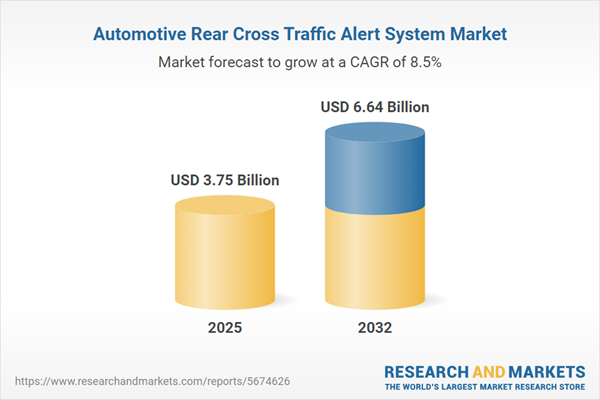Speak directly to the analyst to clarify any post sales queries you may have.
Automotive rear cross traffic alert system adoption is accelerating as organizations seek proven ways to enhance fleet safety and maintain regulatory compliance. Senior decision-makers facing evolving mobility environments are increasingly recognizing the importance of integrating these technologies into fleet operations.
Market Snapshot: Global Rear Cross Traffic Alert System Market
The global rear cross traffic alert system market is undergoing sustained expansion, with current market conditions reflecting rising investments in safety innovations. The sector is advancing from a valuation of USD 3.46 billion in 2024 to USD 3.75 billion in 2025, demonstrating an 8.48% compound annual growth rate (CAGR). This growth is largely propelled by the implementation of stricter vehicle safety mandates and corporate focus on mitigating risks associated with fleet operations. Leading manufacturers and aftermarket service providers are proactively aligning with evolving regulatory frameworks, while diverse regions accelerate solution adoption in direct response to local safety policies. Organizations are steadily integrating these systems, prioritizing risk reduction and operational continuity across international markets.
Scope & Segmentation of the Automotive Rear Cross Traffic Alert System Market
- Vehicle Types: Solutions address heavy trucks, crossovers, SUVs, light commercial vehicles, and passenger cars. This range ensures logistics providers, last-mile operators, and multi-vehicle fleets can suitably align installations, whether for retrofits or new units, to maximize safety outcomes.
- Technology: Platforms utilize camera-based, radar-based, ultrasonic, and integrated multi-sensor detection. Multi-sensor integration strengthens hazard recognition, notably in urban or complex maneuvering situations where visibility is limited.
- Installation Type: Organizations choose between OEM integrations on newly manufactured vehicles or retrofit solutions for existing fleet assets. This flexibility supports the update of older fleets and improves operational readiness, regardless of vehicle age or procurement plan.
- Component: Systems consist of sensors, processors, and tailored software. These elements work together to deliver precise object detection, issue real-time alerts, and enhance adherence to current safety protocols under a unified technical platform.
- End User: Fleet operators focus on interoperable systems that support compliance-driven objectives, while private users prefer intuitive functionality and accessible interfaces to improve everyday driving safety.
- Regions: Americas, Europe, Middle East & Africa, and Asia-Pacific each present distinct compliance and operational needs. Market participants adapt strategies to address specific regulatory and operational requirements within each territory.
- Companies Covered: Major suppliers—Robert Bosch GmbH, Continental AG, Denso Corporation, Valeo SA, ZF Friedrichshafen AG, Aptiv PLC, Magna International Inc., Autoliv Inc., Hella KGaA Hueck & Co., Hyundai Mobis Co. Ltd.—enable delivery of rear cross traffic alert system solutions for global OEMs and fleet managers across varied industries.
Key Takeaways for Senior Decision-Makers
- Rear cross traffic alert systems underpin safety strategies built for compliance with evolving regulations and operational requirements, supporting both large-scale and mixed-asset fleets.
- Integration of technologies such as artificial intelligence and expanded sensor networks promotes real-time hazard identification, supporting safer maneuvering across multiple driving environments.
- Modular product architectures facilitate incremental system upgrades, helping organizations sustain compliance as policies and risk management protocols advance.
- Efficient hardware-software alignment improves life cycle management processes, allowing seamless adaptation to changing safety demands and technical standards.
- Organizations can adapt solution configurations to meet diverse regional compliance needs, enabling harmonized safety programs and reducing administrative complexity.
Tariff Impact: Navigating Supply Chain and Cost Pressures
The projected introduction of U.S. tariffs in 2025 is prompting manufacturers and suppliers of rear cross traffic alert systems to reevaluate global supply chain networks. Key strategies involve expanding supplier sources, bolstering domestic manufacturing capabilities, and establishing new partnerships to stabilize costs and safeguard reliable equipment access. These actions help organizations maintain compliance and operational integrity despite changing trade conditions.
Methodology & Data Sources
This analysis is based on primary research, including interviews with OEMs, technology vendors, and fleet operators. Further data sources include expert panel insights, comprehensive technical evaluations, and regulatory analyses. Proprietary datasets have been integrated to provide a strong foundation for trend identification and actionable recommendations.
Why This Report Matters
- Empowers executive leaders to proactively address rapidly changing requirements in fleet management, supporting future-focused investment in adaptive safety solutions.
- Presents clear and structured frameworks to assess emerging technologies, guiding decision-makers to confidently prioritize technology adoption that aligns with organizational risk and compliance goals.
- Delivers practical planning insights that enhance organizational resilience and enable the design of robust safety programs for evolving fleet environments.
Conclusion
Rear cross traffic alert systems now play a pivotal role in organizational fleet safety planning and risk compliance programs. This report delivers actionable guidance to support effective implementation, aligning with emerging operational and mobility requirements.
Additional Product Information:
- Purchase of this report includes 1 year online access with quarterly updates.
- This report can be updated on request. Please contact our Customer Experience team using the Ask a Question widget on our website.
Table of Contents
3. Executive Summary
4. Market Overview
7. Cumulative Impact of Artificial Intelligence 2025
Companies Mentioned
The companies profiled in this Automotive Rear Cross Traffic Alert System market report include:- Robert Bosch GmbH
- Continental AG
- Denso Corporation
- Valeo SA
- ZF Friedrichshafen AG
- Aptiv PLC
- Magna International, Inc.
- Autoliv Inc.
- Hella KGaA Hueck & Co.
- Hyundai Mobis Co., Ltd.
Table Information
| Report Attribute | Details |
|---|---|
| No. of Pages | 182 |
| Published | October 2025 |
| Forecast Period | 2025 - 2032 |
| Estimated Market Value ( USD | $ 3.75 Billion |
| Forecasted Market Value ( USD | $ 6.64 Billion |
| Compound Annual Growth Rate | 8.4% |
| Regions Covered | Global |
| No. of Companies Mentioned | 11 |









